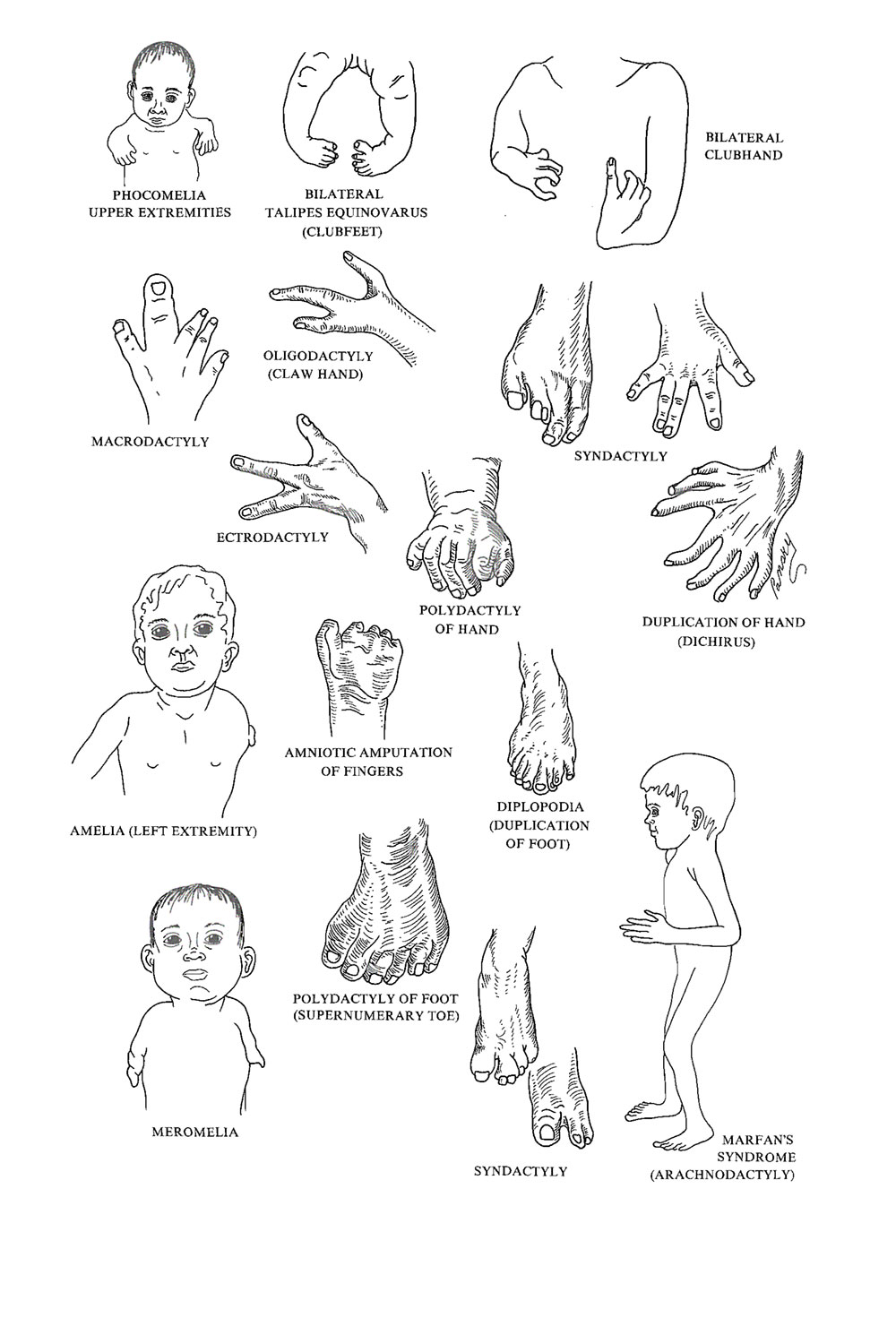71. Malformations of The Appendicular Skeleton (the Limbs)
Review of MEDICAL EMBRYOLOGY Book by BEN PANSKY, Ph.D, M.D.
- Introduction: abnormalities of the extremities vary greatly, and minor defects in development are relatively common. Major limb malformations are rare. Most are of a hereditary nature, such as chromosomal abnormalities. Environmental factors, such as drugs, have often caused an "epidemic" of limb deformities, e.g., thalidomide, which had been used as a sedative and antinauseant. Often, combinations of both environmental and hereditary factors have been involved. In addition, mechanical factors such as reduced amniotic fluid have been associated with limb deformities. In the extreme form, one or both extremities are absent (amelia) or are represented only by hands and feet which are attached to the trunk by small irregular bones (meromelia). Sometimes all segments of the extremities are present but are very short (micromelia)
- Types of deficiencies
- CLEFT HAND OR FOOT (lobster-claw deformities) are rare; 1 or more central digital rays or digits are absent, resulting in a hand or foot divided into 2 parts and opposing each other like a lobster claw. The remaining digits are usually fused (syndactyly)
- CLUB HAND OR CONGENITAL ABSENCE OF RADIUS: the radius is partly or totally absent. The hand deviates to the radial side and the ulna is bowed
- CLUB FOOT OR TALIPES EQUINOVARUS: is common; seen in males more frequently
- The sole of the foot is turned inwards, and the foot is adducted and plantar flexed at the midtarsal joint
- BRACHYDACTYLY: not common; there is an abnormal shortness of the fingers or toes due to size reduction of the phalanges. This is an inherited dominant trait often associated with short stature
- POLYDACTYLY OR SUPERNUMERARY DIGITS: extra fingers or toes are seen; is a common occurrence and due to an inherited dominant trait
- The extra digit may be incompletely formed, lack muscle fixation, and be useless
- In the hand, it is usually found on the radial or ulnar side (not central); in the foot, it is usually on the fibular side
- SYNDACTYLY (FUSED OR WEBBED DIGITS): one of the most common malformations. It is the result of failure of differentiation between 2 or more digits. It is inherited as a simple dominant or recessive trait
- The webbing between the toes or fingers fails to break down during development
- In some cases, there is also fusion of bones
- It is most frequently seen between fingers 3 and 4 and toes 2 and 3
- CONGENITAL HIP DISLOCATION: the capsule of the hip joint is abnormally relaxed at birth with underdevelopment of the acetabulum of the hip and head of the femur
- Dislocation usually takes place after birth
- It is a relatively common phenomenon and is more frequently seen in females
- It is associated with abnormal acetabulum development and joint laxity
- SYMPODIA OR SIRENOMELIA: in this condition, the lower limbs are fused, a defect always associated with a disturbance in the formation of the pelvis
- The single lower extremity most commonly contains a single femur, 2 or 3 bones below the knee, and 5 or 6 digits attached to the foot
- ARACHNODACTYLY (MARFAN'S SYNDROME): uncommon congenital and usually hereditary condition seen in tall slender individuals
- Characterized by thin fingers and toes with elongated phalanges, metacarpals, and metatarsals ("spider" fingers and toes)
- Asymmetry of skull seen in 80% of cases
- Marked atrophy and weakness of all muscles and laxity of ligaments
- 50% have eye deformities
- May see barrel-shaped thorax with kyphosis and marked pronation of feet



